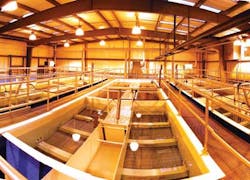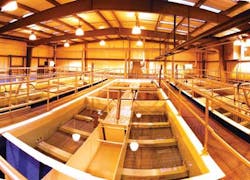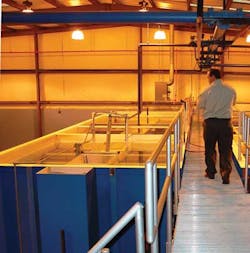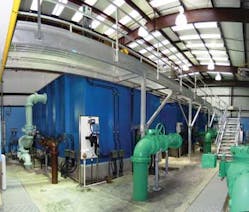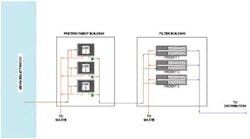By Richard R. Ross
Adding pretreatment to an existing water treatment plant can provide significant process advantages when a plant is faced with challenging influent and stringent effluent water quality regulations. Removing excessive suspended solids early in the treatment scheme reduces the solids loading on subsequent processes, effectively sharing the load among all unit processes.
This distribution of treatment processes often allows components to operate more efficiently than otherwise would have been expected. In the later filter polishing step, longer filter runs between backwashes result in significantly reduced backwash waste and time offline for the process. Without proper pretreatment, water plant operators often scramble in an effort to provide proper chemical feed rates and to avoid process upsets. As such, operators can sometimes be forced to shut down the water plant if it is unable to produce acceptable effluent quality water.
Accordingly, the Eastern Band of Cherokee Indians (EBCI) faced most of these challenges at their water treatment plant. High influent turbidity conditions - in some cases as high as 300 to 400+ NTU from the Oconaluftee River in western North Carolina - reduced overall net plant production as a result of frequent backwashes and clarifier flushes. In some cases, plant operation was brought to a standstill due to turbidity loads above the effective capacity of the existing plant.
Faced with an expansion of their community and gaming resort, the EBCI sought to increase their water treatment plant's capacity from 4 to 6 MGD and to allow for more consistent operation during high turbidity events. This required adding another packaged treatment unit and some form of pretreatment to manage the high turbidity influent.
The existing plant consisted of two packaged water treatment units (Microfloc Trident TR840 units) installed in 1994. The two steel tanks, each rated at 2 MGD, included an up-flow adsorption clarifier running at 10 gpm/ft2 followed by a down-flow mixed media filter running at 5 gpm/ft2.
With the previous plant design, raw water was pumped from the river to the water plant and dosed with alum and polymer. The water then flowed into the bottom of the packaged treatment unit and upward through the adsorption clarifier. The adsorption clarifier uses a four-foot depth of HPDE beads roughly 2.5 mm in diameter with an SG <1.0. Media is contained within the clarifier compartment using a stainless steel screen attached to an aluminum grating. Coagulated particles collect in the bed until a pressure buildup of four feet of water column (1.7 psi) is obtained, at which time a clarifier flush process is initiated to remove the entrained solids. The clarifier flush process uses a combination of air to expand the media and raw water to flush the contaminants to waste. Once this is completed, the clarifier returns to service.
From the clarifier, water overflows into the down-flow mixed media filter. Filter media is installed in three layers: high-density garnet, silica sand and anthracite. The total filter depth is 30 inches, and a garnet layer provides a final polishing step with a 0.2 mm effective size. As solids accumulate in the filter bed and a head loss of eight feet of water column (3.4 psi) develops across the bed, a backwash will occur. Finished water is used to backwash the filter, assisted in the generation Trident system by surface sweeps suspended above the media bed. These units were updated to include air-assisted backwash, as discussed below.
Historically, the river provided a consistent supply with a raw water turbidity of approximately 2 to 4 NTU, resulting in filter runs of 20+ hours and clarifier flushes of 8+ hours. However, periodic turbidity spikes up to 300 NTU interrupted normal plant operations and interfered with consistent water supply. During high turbidity spikes, the plant operators shut down the units, drawing their water from system storage tanks.
Having anticipated the need for future expansion, in 1994 the original water treatment plant was designed to accommodate a third 2-MGD package treatment unit. The performance of the existing package treatment units was considered to be exemplary except during high-turbidity events. However, the EBCI desired a solution that would allow continuous operation, even during these events, where turbidity could exceed 300 NTU for extended periods. It was also desirable to incorporate a solution that would account for upcoming regulations, such as the Long Term 2 (LT2) Surface Water Treatment Rule.
The selected pretreatment option was an upflow tube clarifier system that incorporates sludge recirculation to enhance particle coagulation. This high-rate tube clarification system (Microfloc Trident HSR-1400) is a modular solution, delivered in a packaged design in steel tanks. For this application, three steel tank units rated for 2 MGD each were installed in parallel with a common discharge line and provide the 6 MGD of required pretreatment to the three adsorption clarifier/filter packaged treatment units located upstream.
Influent raw water is treated with an anionic polymer to increase the settleability of the solids. Recirculated sludge solids are also added to the influent water to aid in floc formation. Raw water enters the unit and moves upward through the tube modules, and clarified water is collected by a header/lateral system consisting of perforated PVC pipe.
A gravity-driven sludge removal system includes a collection header that reciprocates below the tube modules and collects the coagulated and settled solids. The sludge collection header is connected to a sludge transfer pump that moves some portion of the collected sludge back to the raw water feed to aid in floc formation. The unit periodically "blows down" solids to maintain a proper solids inventory in the unit.
Finally, a clarifier flow-forwarding pump moves the water to the next step in the treatment process: the adsorption clarifier/filter units located in a building adjacent to the pretreatment building.
Combined with the adsorption clarifier and filter operations in the package treatment units, a three-barrier treatment system is created that produces high-quality effluent water despite process upsets such as raw water turbidity spikes.
With the three pretreatment units working in parallel prior to the three packaged treatment units, the modular units provide enhanced plant flow capability. The pretreatment units can operate as low as 50 percent of nominal capacity, owing for reduced upflow rates when the plant is operating below maximum capacity. For example, when operating at 3 MGD, the three pretreatment units are operating at half capacity (2.5 gpm/ft2), allowing for better clarification and more time for solids settling to occur. At a plant flow of 6 MGD, loading rates are 5 gpm/ft2 in the pretreatment units.
The plant uses a pressure transmitter to bias the flow setpoint in order to correct for flow meter error that can occur when using two or more flow control loops in series. In this case, flow control must be managed between the pretreatment systems and the package units. A pressure transmitter was installed in the header between the two systems. This transmitter has a pressure setpoint that will determine how much to add or subtract from the flow setpoint on the package units in service to adjust for error between the pretreatment influent flow meters and the package system influent flow meters.
This influent flow control logic uses this bias to prevent erratic influent valve oscillations. In this manner, the operation of the plant is managed by a common flow setpoint for production. This flow setpoint is divided and split to all pretreatment units available, down to a minimum operation of 50-percent flow. The setpoint is then compared to the design flow rate on the package treatment units to determine how many units to place in service and at what flow rate.
The two existing package treatment units were upgraded to incorporate the design improvements available on current generation treatment systems. These included direct retention underdrains (General Filter MULTIBLOCK with Laser Shield), simultaneous air/water backwash replacing the existing surface wash sweeps, and ultrasonic level controllers. These improvements would match the existing package units to the new third unit.
The direct retention underdrains are a dual lateral design with orifices between the primary and secondary chambers providing ample distribution of air and water during the backwash process along the length and width of the filter box. This ensures that the media is evenly scoured during the backwash process where excessive chemistry or contaminants can build up and create filter problems. The underdrain also incorporates a stainless steel, laser-cut slotted cap or shield on which the media directly sits. This eliminates the need for support gravel and allows for direct retention of the 0.2 mm garnet media. The slots combined with the orifices drilled between the chambers of the underdrains ensure minimal misdistribution around the filter compartment during the backwash process. These are installed atop an effluent flume box, which is cemented and grouted in the bottom of the filter compartment.
The stainless steel cap is not only corrosion-resistant but also uses sharp edge slots providing a direct path for water flow. Often porous cap designs can become fouled with contaminants, restricting flow and causing a build up of excessive pressure during the backwash process - in some cases even resulting in catastrophic failure of the underdrain system.
The water level in the filter compartment was controlled by a hydro-mechanical level control that sometimes became fouled and malfunctioned. As such, the operator would be required to annually calibrate this device and even more frequently clean the probes so it would function reliably. The new non-contact ultrasonic level controllers were installed to provide virtually maintenance-free level measurement of the filter box, providing enhanced reliability of effluent flow control logic. Also, the existing chemical feed systems were upgraded to include state-of-the-art polymer blending systems.
The storage and containment area was installed in the pretreatment building providing the chemicals for fluoride, sodium bicarbonate for pH control, phosphate for corrosion control, alum, and anionic polymer. The local polymer feed was installed next to the pretreatment units using a combined polymer activation/feed system (Polyblend M Series).
In a resort community, a weather event encourages tourists to stay indoors, which increases water demand. A recent rain event at the Cherokee WTP saw influent turbidities exceed 300+ NTU. Before, this would have resulted in a plant shutdown and the need to draw water from storage tanks. With the pretreatment units installed, the water plant continued to operate effectively without shutting down. With construction of this new expanded plant now completed, this facility is well prepared to meet the water demands and comply with federal regulations, including the LT2 Surface Water Treatment Rule, and will be able to provide sufficient water to meet the demand from recent development.
About the Author: Richard R. (Rich) Ross, PE, is a regional product manager for General Filter & Microfloc products at WesTech Engineering, Inc. Based in upstate New York, Rich joined USFilter in 1992 as a project engineer/project manager on both municipal water and wastewater products. He became the product manager in 2004 serving the east coast. He holds a BSME degree from the Rochester Institute of Technology, in Rochester, N.Y., and is a registered professional engineer.
